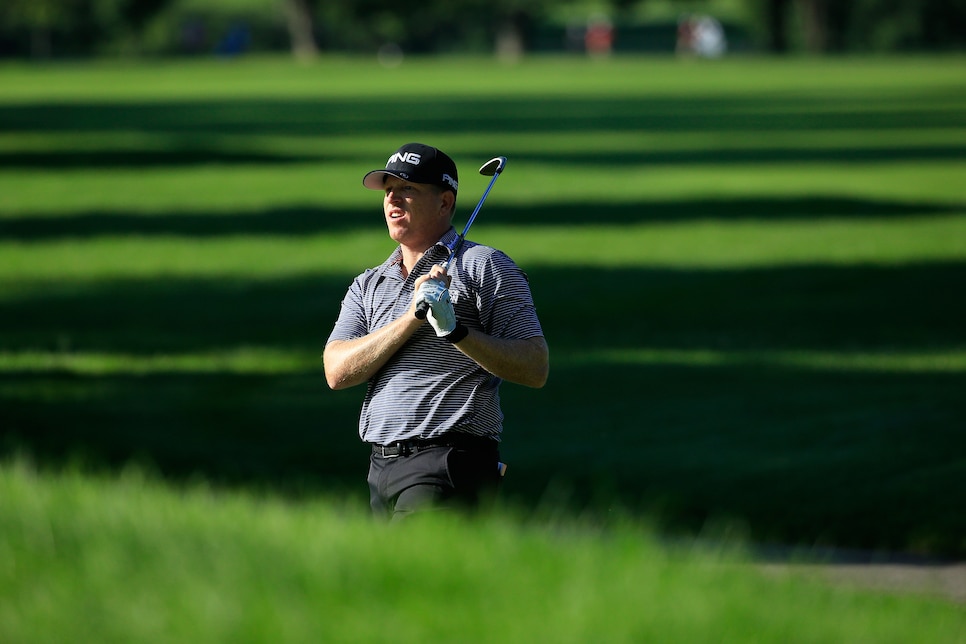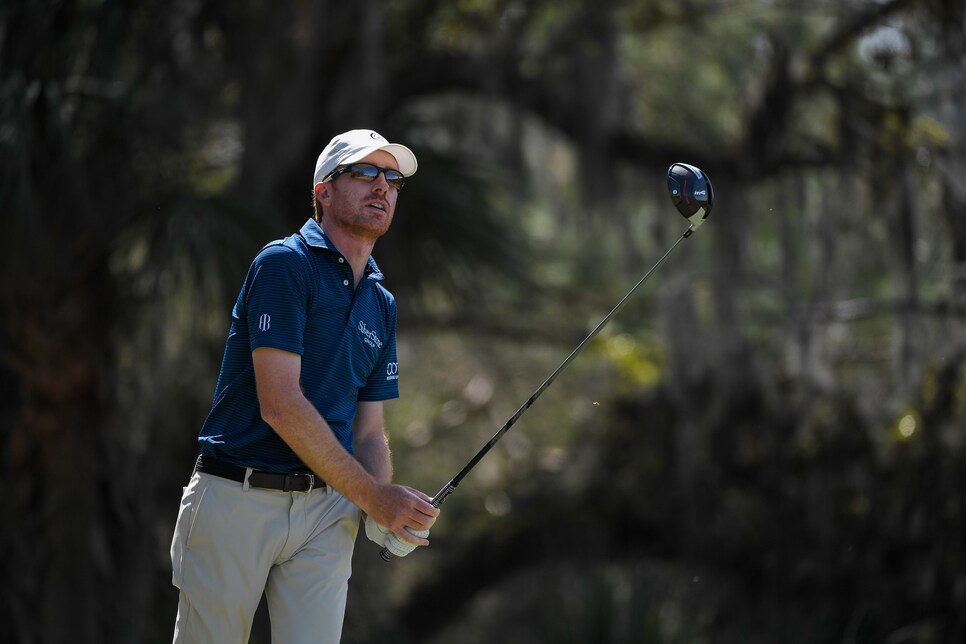News
Starting over: When you lose your tour card

The number was 5,509. That’s how many strokes Martin Piller took on the PGA Tour last season. He needed 5,508.
The shaved stroke could have come at Mayakoba or Palm Springs. It would have done the trick in Dallas or Houston as well. Without a doubt, it was the difference in Greensboro. Piller entered the regular-season finale, the Wyndham Championship, 124th in the FedEx Cup standings. The top 125 players advance to the postseason; more importantly, they keep full tour membership the following year.
“I thought I was in good shape,” says Piller, a Texas native whose wife Gerina plays on the LPGA Tour. “I was two under through two days. That felt like it was going to be enough.”
It wasn’t. Piller missed the cut by one shot. Nick Taylor and Harris English, both on the outside of the top 125 to start the Wyndham, made the weekend, grabbing enough points for playoff invites. Piller dropped to 126th.
One shot. One shot and Piller would have kept his card, and the splendor and security that come with it. Instead the 33-year-old is here. What “here” is … well, it’s tough to explain.
“To be honest, I’m not sure how to describe it,” Piller says.
• • •
Professional golf is said to be the purest rendition of sports meritocracy. Which is true, but also diplomatic. At its core, stripped of refinement and nuance, it’s cannibalistic. Absolutely and unequivocally merciless.
Last season, 174 golfers, including a contingent of European Tour members, made 20 or more appearances on tour. If historical trends hold, of those 174, between 40 and 45 won’t sniff that benchmark in 2019. That’s a competitor turnover hovering around 25 percent. For context, no other major sports league cracks 16 percent.
All walks of tour life are represented in the 25 percent; it is democratic in its axing. No-names and journeymen, yes, as well as veterans, former prodigies, tour winners and major champs. Last year’s notables included Graeme McDowell, Bill Haas, Chad Campbell and Aaron Baddeley.
Why the high turnover? Much of this is due to to the lack of guaranteed contracts—multi-year exemptions earned by winning tour events provide immunity to just 65 or so individuals. The rest play a game of musical chairs, hoping they have a seat after Wyndham, when the music stops.
“It is one of those things where you're constantly having to prove yourself,” says Roberto Castro, 33, who has logged more than 150 career PGA Tour starts. Adds Will Wilcox, famous for recording an ace at the 17th at Sawgrass: “There are so many good players out here now … There’s not much room for error.”
So what happens when they do? What happens when players lose their tour cards?

Ryan Young
• • •
There are three levels for non-exempt players:
• Players ranked 126th-150th in the FedEx Cup, who are given conditional PGA Tour status for the season and are fully exempt on the Web.com Tour.
• Players ranked 151st-200th, who have conditional Web.com Tour status.
• Players ranked 201st and lower, who receive no status.
Option No. 1 is the desired fate, at least out of the three, as it presents a direct route back to the PGA Tour. Piller himself has already played three PGA Tour events in the 2018-'19 season, with another 10 or so likely on the docket.
However, it is not without drawbacks. Players are essentially part of two tours and none at the same time. Case in point: Piller’s schedule predicament. Due to his position in the PGA Tour’s priority rankings, he doesn’t know if he will play in the Desert Classic (formerly the CareerBuilder Challenge) next week. Full-membership players don’t have to commit until the Friday before, and non-exempt players who finish in the top 10 at the Sony Open will earn a spot in the field. Only then can conditional-status players gain entry.
The wait is problematic for all the reasons associated with last-second travel planning. The situation is complicated by the fact that the Web.com Tour’s season-opening Bahamas event starts this Sunday.
“So do you go to the Bahamas where you know you can play, or do you hold out hope?” Piller wonders. “Clearly, I want to go to Palm Springs, but what if I’m bumped out? That means I’m sitting at home, or traveling to Palm Springs hoping someone drops out during the week.”
This is not an aberration. Piller faces a similar quagmire with next month's AT&T Pebble Beach Pro-Am. Reading the forecasts, he should—should—be in the Clambake. There’s also a very real possibility, because of the factors listed above, he gets the boot. If that comes to pass, it’s a doozy of an itinerary change, eschewing the patina and glitz of Pebble for … Panama City, some 2,500 miles away. A distance underlining the expanse between the two worlds.
And what happens if a player is struggling? Do you continue to chase the big check on the PGA Tour or take your medicine on the Web.com, where the competition is fierce and the course set-ups are not, providing a possible psychological boost to your game the big tour may not afford.
“This is new for me,” Piller avowed, in his ninth year as a professional, but his first in this seesaw status. “It feels like a lot of waiting.”
Keep in mind, Piller is on the preferred route.

Ryan Young
Then there’s the second group, those with conditional Web.com status. This designation is usually good for entry into half the Web.com slate, sometimes more if a player has clout. Castro operated in this realm last summer, PGA Tour vet Scott Langley the year before.
The semblance of steady work can't be overlooked, particularly at this level. Still, there are trials. Starting with an adjustment to the surroundings.
“Coming from the PGA Tour made the Web events I played seem pretty bare bones,” said Langley, 29, a former NCAA individual champion at Illinois and low amateur at the U.S. Open in 2010. “It took more effort and more ownership on my part to play well and stay healthy.”
Before we travel too far down this road, it’s worth noting, to a man, players were effusive in praise for Web.com Tour president Dan Glod and the improvements he and his staff have made to the tour. Whatever aspersions are attached to minor-league operations need to be checked, as more than 50 players pulled in six-figure earnings in 2018. That’s in the top 10 percent of individual American incomes.
In that same breath, it’s faint cry from the PGA Tour, where 114 players pulled in a million bucks and 194 made more than $200,000. Sam Burns, who finished second on the Web.com money list in 2018, would have ranked 184th on the PGA Tour.
That cut can be a rude awakening. Rental homes and Ritz-Carltons are subbed out for the Fairfield Inn, and players think twice before booking a first-class ticket. "Travel costs the same, no matter what tour you're playing," Piller says.
Cash is not the only thing slashed. Media attention is basically non-existent. PGA Tour ranges are littered with teams of agents, instructors, lackeys and general parvenus. In the feeder circuit, most players fly solo. Crowds at Web events are not much to speak of; ditto the amenities—food, gifts, valets—available to players and their loved ones. With less money to go around caddie relationships are tenuous, with a host of players grabbing a new looper on a routine basis.
"On the tour, there are hundreds of volunteers waiting on your every wish, and the wishes of your family," Wilcox said. "When you arrive at the airport, there's someone to hand you keys to a free Mercedes-Benz for the week. On the Web, there might be one volunteer for every 30 players, if that."
Again, these guys aren't making peanuts, traveling by Greyhound from stop-to-stop and sleeping eight to a room. But golfers, as much as any other athletes, are creatures of habit. The transition can be a tough swallow.
"I quickly felt like a rookie again," Langley said. "All new courses, new cities, a few interesting international events. It presented a whole new challenge, and I had to do a lot more on my own to prepare in the same way I was able to prepare on the PGA Tour."
"Challenges" brings us to the third sect, those without status. A majority of the time, this comes with a caveat: former fully exempt PGA Tour players are still high on the eligibility ranking, and past Web.com Tour champions aren't far behind. There's also the chance to gain eight-to-12 guaranteed starts with a good finish at Web.com Tour Q School.
"The nightmare," as two players called it, is more abstract than actual. However, the reality of no safety net is a scary proposition.
"You feel like you're at square one," says Wilcox, who missed the top 200 in 2017 by a fraction of a point. "Missing by that much took me to the bottom of the barrel."
Players are in full scramble mode. That means writing events for sponsor's exemptions, asking agents and friends of friends for favors, competing in Monday qualifiers. It's a hustle.
Some notice certain friends stop calling when they're no longer in the top ranks. Same goes for the corporate endorsements. For those used to the world at their feet, ego can be shattered.
Nevertheless, they go, onward. Adapt or die.
"If you're a golfer you're used to being humbled," Castro said. "Every player no matter how good, has taken a bad beat and has had to figure out how to let it go and keep going."

Steve Dykes
• • •
Which raises the most crucial element of losing your card: the crisis of confidence. True, every golfer at every skill level wrestles with conviction. This is different. Their game, their place in it, their new environment, everything is re-calibrated. "At one point I looked around and wondered, 'Should I be out here, or should I be giving lessons?'" Wilcox said.
It's a fair question, one that should be asked. Not doing it can bring dire consequences. Langley admitted he was guilty on this front, and the results showed, struggling through his first year on the Web.com Tour.
"I had a bad attitude, and was in danger of losing my Web card and going back to Q School," he said. "I made a promise to myself at the midway point of that year that I was going to operate in a 'no complaints' zone.
"The Web Tour wasn’t the PGA Tour, so what? It still provided me opportunities to compete against great players and elevate my career back to where I wanted to be."
A near-universal epiphany. It takes longer for some to get there, but they do, eventually. Whatever their current standing, players point to this setback, losing your card, as a catharsis. Better yet, without the tour's bells and whistles, the tinsel and noise, the game—to which a handful conceded had stopped being fun when it became a career—becomes a game again.
"On tour, I was so wrapped up in what I was doing, I didn't get to smell the roses," Wilcox said.
The 32-year-old remains committed to returning to the PGA Tour. Conversely, if he never makes it back, there will be no bitterness. "Golf gave me a life, a good life," Wilcox said. "I'm lucky to be doing what I'm doing."
There's a stigma, generated by media and fans and fellow players, that comes with losing your card. It's also one rejected to those that have experienced it. They paint the journey in a positive light.
"After six years on tour, the Web.com was certainly not what I wanted to be doing. But I shifted my thinking by reminding myself that in a vacuum, the Web.com Tour is still a great opportunity," Castro said. "There is a greater appreciation for what I've accomplished."
"I appreciate and notice all of the perks on tour more after not having them for a little while," said Langley, who regained his card last fall. "But the bigger change for me is I really appreciate the good tournaments more now. I have more gratitude for playing good golf. My perspective is a lot different than it used to be; I probably “need” to play well less than I ever have, but I also enjoy playing well more than I ever have.
"This change brings me a lot of peace on the golf course."
Besides, as they all point out, they are close. Their games, their dreams, remain in reach. "You are always six good months away, one great week away," Langley said.
Or, as Piller knows all too well, one shot.

